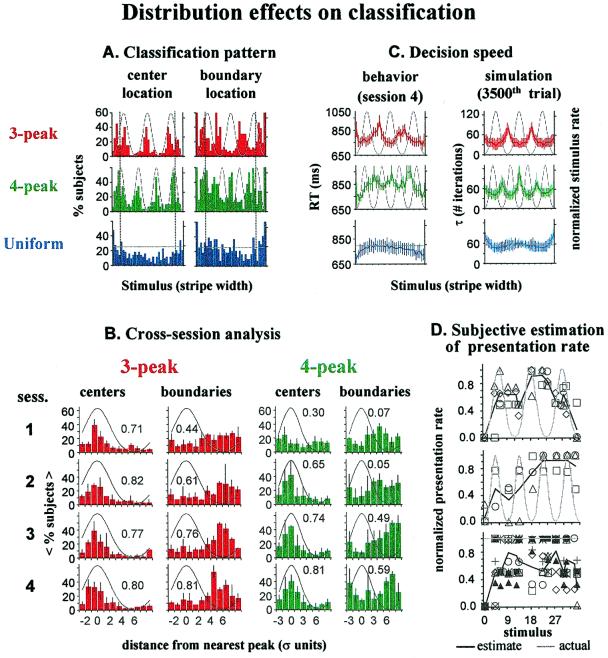Figure 3.
Stimulus distribution effect on classification. (A)
Histograms of class center (Left) and boundary
(Right) location for each case, during the fourth
classification session, reflecting clear correlation with the
statistical pattern of the stimulation in the multipeak cases. Bars of
each histogram denote percentage of subjects who had a class center
(boundary) at each stimulus. Class center location was computed as the
center of gravity of the sorting coherence function, χ, between the
two boundaries, i.e., Σ b ⋅ χ(b, c)/Σ
b ⋅ χ(b, c)/Σ χ(b, c).
Dashed lines indicate range of edge effects. (B)
Cross-session development of the distribution effect: the center and
boundary location histograms of each session are reorganized according
to distance from the nearest peak. Bars indicate average percent of
subjects locating center or boundary at a specific distance from
distribution peak. Error bars denote SD. Numbers are correlations
between histograms and the distribution characteristics. Note slower
evolution of the effects in the four-peak case. (C)
Distribution effect on decision speed. Colored curves indicate
cross-subject average behavioral RT data (Left) and
simulation convergence time τ (Right). Error bars denote
SE and SD of the behavioral and simulation results, respectively. The
longer RTs near less frequent stimuli was successfully imitated by the
simulation τ. However, τ increased near range edges, where RTs were
shorter. (D) Absence of subject awareness of the statistical
structure of the stimuli. Dark curves present the cross-subject average
subjective rate of presentation frequency (on a five-level scale;
normalized between lowest and highest). Data were collected after
completion of the classification experiment, where subjects were asked
to estimate the frequency of a few serially presented stimuli (usually
15; always including the most and least frequent). Symbols indicate
individual estimates. Subjective estimations were not correlated with
actual stimulus distributions.
χ(b, c).
Dashed lines indicate range of edge effects. (B)
Cross-session development of the distribution effect: the center and
boundary location histograms of each session are reorganized according
to distance from the nearest peak. Bars indicate average percent of
subjects locating center or boundary at a specific distance from
distribution peak. Error bars denote SD. Numbers are correlations
between histograms and the distribution characteristics. Note slower
evolution of the effects in the four-peak case. (C)
Distribution effect on decision speed. Colored curves indicate
cross-subject average behavioral RT data (Left) and
simulation convergence time τ (Right). Error bars denote
SE and SD of the behavioral and simulation results, respectively. The
longer RTs near less frequent stimuli was successfully imitated by the
simulation τ. However, τ increased near range edges, where RTs were
shorter. (D) Absence of subject awareness of the statistical
structure of the stimuli. Dark curves present the cross-subject average
subjective rate of presentation frequency (on a five-level scale;
normalized between lowest and highest). Data were collected after
completion of the classification experiment, where subjects were asked
to estimate the frequency of a few serially presented stimuli (usually
15; always including the most and least frequent). Symbols indicate
individual estimates. Subjective estimations were not correlated with
actual stimulus distributions.

